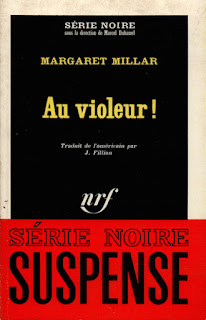Several years ago, I had the idea of including Margaret Millar in the Véhicule Press Ricochet series. My plan was to revive every one of the out-of-print novels she'd set in Canada: The Devil Loves Me, Wall of Eyes, The Iron Gates, and Fire Will Freeze. I was hoping to find some way of adding An Air That Kills, her last with a Canadian setting, though it was then in print from Stark House Press.
By great coincidence, I knew Millar's literary executor; we'd first met decades ago, when the author was still alive. Response to my query brought the news that Syndicate Books had just negotiated the rights to reprint every single Margaret Millar title.
As a series editor, I was discouraged; as a fan, I could not have been more excited. At long last, I'd be afforded the opportunity to read uncommon Millar novels like The Invisible Worm, The Weak-Eyed Bat, Experiment in Spring, and Wives and Lovers.
The first volume of Syndicate's seven-volume Complete Millar, was published in September 2016. Titled The Master at Her Zenith, it includes Vanish in an Instant, Wives and Lovers, Beast in View, An Air That Kills, and The Listening Walls. Four more volumes have followed, returning a total of twenty-two novels to print. I've been pacing myself. The last two volumes of the Complete Millar will be published this year.
"Arguably the most talented English-Canadian woman writer of her generation, as a genre writer who lived much of her life in the United States Millar is often ignored by Canadian critics," I wrote in Millar's Canadian Encyclopedia entry. Had it not been for Gabrielle Roy, "English-Canadian" would've been unnecessary.
Is Roy still well known amongst Anglophones? The Tin Flute is studied, which is more than can be said about anything by Millar. This month, Roy's Street of Riches and The Road Past Altamont are being added to Penguin's Modern Classics series.
Sixty-seven years have passed since the publication of The Invisible Worm, Millar's debut, and she has never once had a Canadian publisher. Now is the time for French-language publishers of my home province to embrace her. Nearly every Millar mystery has been translated by Parisian publishers... and nearly all are out of print. As a starting point, I recommend Omelette Canadienne, the translation of Fire Will Freeze, the only Millar novel set in Quebec.
I'll leave you with four favourites.
 |
| La femme de sa mort [Vanish in an Instant] Paris, Presses de la Cité |
 |
| Mortellement votre [Beast in View] Paris: Presses de la Cité, 1957 |
 |
| Un air qui tue [An Air That Kills] Paris: Presses de la cité, 1958 |
 |
| Au violeur! [The Fiend] Paris: Gallimard,1966 |
Related posts:
Margaret Millar's Great Toronto Murder Mystery
Margaret Millar's Michigan Murder Mystery
The Telephone Always Rings
Margaret Millar's Michigan Murder Mystery
The Telephone Always Rings








































